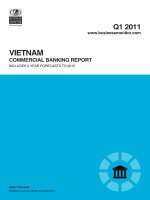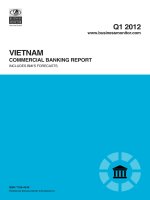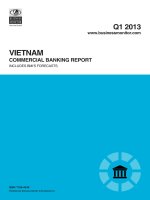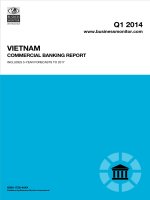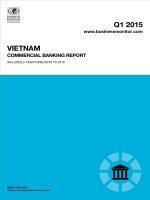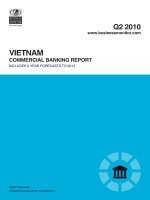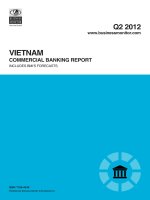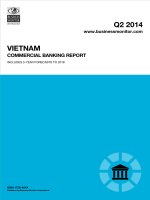Vietnam commercial banking report q4 2015
Bạn đang xem bản rút gọn của tài liệu. Xem và tải ngay bản đầy đủ của tài liệu tại đây (412.09 KB, 74 trang )
Q4 2015
www.bmiresearch.com
VIETNAM
COMMERCIAL BANKING REPORT
INCLUDES 5-YEAR FORECASTS TO 2019
ISSN 1758-454X
Published by:BMI Research
Vietnam Commercial Banking Report Q4
2015
INCLUDES 5-YEAR FORECASTS TO 2019
Part of BMI’s Industry Report & Forecasts Series
Published by: BMI Research
Copy deadline: August 2015
BMI Research
Senator House
85 Queen Victoria Street
London
EC4V 4AB
United Kingdom
Tel: +44 (0) 20 7248 0468
Fax: +44 (0) 20 7248 0467
Email:
Web:
© 2015 Business Monitor International Ltd
All rights reserved.
All information contained in this publication is
copyrighted in the name of Business Monitor
International Ltd, and as such no part of this
publication may be reproduced, repackaged,
redistributed, resold in whole or in any part, or used
in any form or by any means graphic, electronic or
mechanical, including photocopying, recording,
taping, or by information storage or retrieval, or by
any other means, without the express written consent
of the publisher.
DISCLAIMER
All information contained in this publication has been researched and compiled from sources believed to be accurate and reliable at the time of
publishing. However, in view of the natural scope for human and/or mechanical error, either at source or during production, Business Monitor
International Ltd accepts no liability whatsoever for any loss or damage resulting from errors, inaccuracies or omissions affecting any part of the
publication. All information is provided without warranty, and Business Monitor International Ltd makes no representation of warranty of any kind
as to the accuracy or completeness of any information hereto contained.
CONTENTS
BMI Industry View 7
Table: Commercial Banking Sector Indicators 7
Table: Commercial Banking Sector Key Ratios, December 2014 7
Table: Annual Growth Rate Projections 2014-2019 (%) 7
Table: Ranking Out Of 75 Countries Reviewed In 2015 8
Table: Commercial Banking Sector Indicators, 2012-2019 8
SWOT 9
Commercial Banking 9
Political 10
Economic 11
Operational Risk 13
Industry Forecast 15
Industry Risk Reward Ratings 20
Asia Commercial Banking Risk/Reward Index 20
Table: Asia Commercial Banking Risk/Reward Index 21
Market Overview 22
Asia Commercial Banking Outlook 22
Table: Banks' Bond Portfolios, 2013 22
Table: Comparison Of Loan/Deposit & Loan/Asset & Loan/GDP Ratios, 2015 22
Table: Comparison of Total Assets & Client Loans & Client Deposits (USDbn) 23
Table: Comparison Of USD Per Capita Deposits, 2015 24
Economic Analysis 25
Table: Economic Activity (Vietnam 2010-2019) 30
Competitive Landscape 31
Market Structure 31
Protagonists 31
Table: Protagonists In Vietnam's Commercial Banking Sector 31
Definition Of The Commercial Banking Universe 31
List Of Banks 32
Table: Financial Institutions In Vietnam 32
Company Profile 34
Agribank 34
Table: Balance Sheet (VNDmn) 36
Table: Balance Sheet (USDmn) 36
Table: Key Ratios (%) 37
Bank for Foreign Trade of Vietnam (Vietcombank) 38
Table: Stock Market Indicator 40
Table: Balance Sheet (VNDmn) 40
Vietnam Commercial Banking Report Q4 2015
© Business Monitor International Ltd Page 4
Table: Balance Sheet (USDmn) 41
Table: Key Ratios (%) 41
Eximbank 42
Table: Stock Market Indicators 44
Table: Balance Sheet (VNDmn) 44
Table: Balance Sheet (USDmn) 44
Table: Key Ratios (%) 45
Sacombank 46
Table: Stock Market Indicators 48
Table: Balance Sheet (VNDmn) 48
Table: Balance Sheet (USDmn) 48
Table: Key Ratios (%) 49
VietinBank 50
Table: Stock Market Indicators 52
Table: Balance Sheet (VNDmn) 52
Table: Balance Sheet (USDmn) 52
Table: Key Ratios (%) 53
Regional Overview 54
Asia Overview 54
Global Industry Overview 58
Global Commercial Banking Outlook 58
Demographic Forecast 64
Table: Population Headline Indicators (Vietnam 1990-2025) 65
Table: Key Population Ratios (Vietnam 1990-2025) 65
Table: Urban/Rural Population & Life Expectancy (Vietnam 1990-2025) 66
Table: Population By Age Group (Vietnam 1990-2025) 66
Table: Population By Age Group % (Vietnam 1990-2025) 67
Methodology 69
Industry Forecast Methodology 69
Sector-Specific Methodology 70
Risk/Reward Index Methodology 71
Table: Commercial Banking Risk/Reward Index Indicators 72
Table: Weighting Of Indicators 73
Vietnam Commercial Banking Report Q4 2015
© Business Monitor International Ltd Page 5
BMI Industry View
Table: Commercial Banking Sector Indicators
Date
Total
assets Client loans
Bond
portfolio Other
Liabilities
and capital Capital
Client
deposits Other
December 2013, VNDbn 4,498,816 3,469,680 531,489 497,647 4,498,816 632,536 3,786,435 79,845
December 2014, VNDbn 5,209,740 3,949,680 746,862 513,198 5,209,740 651,877 4,482,998 74,865
% change y-o-y 15.8% 13.8% 40.5% 3.1% 15.8% 3.1% 18.4% -6.2%
December 2013, USDbn 213.3 164.5 25.2 23.6 213.3 30.0 179.5 3.8
December 2014, USDbn 243.6 184.7 34.9 24.0 243.6 30.5 209.6 3.5
% change y-o-y 14.2% 12.3% 38.6% 1.7% 14.2% 1.6% 16.8% -7.5%
Source: BMI; Central banks; Regulators
Table: Commercial Banking Sector Key Ratios, December 2014
Loan/deposit ratio
Loan/asset ratio Loan/GDP ratio GDP Per Capita, USD Deposits per capita, USD
88.10% 75.81% 100.3% 2,134.0 2,264.8
Rising Rising Rising n.a. n.a.
na = not available. Source: BMI; Central banks; Regulators
Table: Annual Growth Rate Projections 2014-2019 (%)
Assets Loans Deposits
Annual Growth Rate 10 8 5
CAGR 11 9 6
Ranking 22 28 44
Source: BMI; Central banks; Regulators
Vietnam Commercial Banking Report Q4 2015
© Business Monitor International Ltd Page 7
Table: Ranking Out Of 75 Countries Reviewed In 2015
Loan/deposit ratio Loan/asset ratio Loan/GDP ratio
14 5 16
Local currency asset growth Local currency loan growth Local currency deposit growth
18 23 31
Source: BMI; Central banks; Regulators
Table: Commercial Banking Sector Indicators, 2012-2019
2012 2013 2014 2015f 2016f 2017f 2018f 2019f
Total assets, VNDbn 3,917,557 4,498,816 5,209,740 5,887,006 6,593,447 7,318,726 8,123,786 8,963,244
Total assets, USDbn 188 213 244 273 309 346 388 432
Client loans, VNDbn 3,077,700 3,469,680 3,949,680 4,384,145 4,822,559 5,256,590 5,729,683 6,207,156
Client loans, USDbn 148 164 185 203 226 249 273 299
Client deposits, VNDbn 3,080,455 3,388,501 3,693,466 3,988,943 4,268,169 4,524,259 4,795,715 5,051,486
Client deposits, USDbn 148 161 173 185 200 214 229 243
e/f = estimate/forecast. Source: BMI; Central banks; Regulators
Vietnam Commercial Banking Report Q4 2015
© Business Monitor International Ltd Page 8
SWOT
Commercial Banking
Vietnam Commercial Banking SWOT
Strengths
■
Untapped market with potential for increased participation of foreign banks.
■
Large population with a high savings rate and potential for income growth.
■
The Vietnamese government aims to speed up the process of privatising state-owned
banks, which will help modernise the industry.
■
State-owned banks will gradually play a lesser role going forward, and the risks
associated with state-directed lending will decrease over time.
Weaknesses
■
Domestic banks continue to lag behind their foreign peers in terms of financial
strength and the technological curve.
■
Accounting standards lag behind international standards and the lack of transparency
entails significant risks for foreign investors.
■
Small banks have an overwhelming exposure to real estate and individual loans,
resulting in highly skewed and risky loan portfolios.
Opportunities
■
The country remains one of the most under-banked in the region, with significant
potential for adopting cash-free payment systems and new mobile banking
technologies.
■
Rising income levels and deepening capital markets could give rise to opportunities in
more sophisticated financial products and growth for the local asset management
industry.
Threats
■
Track record of macroeconomic instability threatens the credibility of the government
and could potentially drive economic policy away from further liberalisation.
■
The high level of government debt risks triggering a fiscal crisis, undermining
confidence in the banking sector.
Vietnam Commercial Banking Report Q4 2015
© Business Monitor International Ltd Page 9
Political
SWOT Analysis
Strengths
■
The Communist Party of Vietnam remains committed to market-oriented reforms and
we do not expect major shifts in policy direction over the coming years. The one-party
system is generally conducive to short-term political stability.
■
Relations with the US have witnessed a marked improvement, and Washington sees
Hanoi as a potential geopolitical ally in South East Asia.
Weaknesses
■
Corruption among government officials poses a major threat to the legitimacy of the
ruling Communist Party.
■
There is increasing (albeit still limited) public dissatisfaction with the leadership's tight
control over political dissent.
Opportunities
■
The government recognises the threat corruption poses to its legitimacy, and has
acted to clamp down on graft among party officials.
■
Vietnam has allowed legislators to become more vocal in criticising government
policies. This is opening up opportunities for more checks and balances within the
one-party system.
Threats
■
Although strong domestic control will ensure little change to Vietnam's political scene
in the next few years, over the longer term, the one-party-state will probably be
unsustainable.
■
Relations with China have deteriorated over recent years due to Beijing's more
assertive stance over disputed islands in the South China Sea.
Vietnam Commercial Banking Report Q4 2015
© Business Monitor International Ltd Page 10
Economic
SWOT Analysis
Strengths
■
Vietnam has been one of the fastest-growing economies in Asia in recent years, with
GDP growth averaging 6.5% annually between 2000 and 2014.
■
The economic boom has lifted many Vietnamese out of poverty, with the official
poverty rate in the country falling from 58% in 1993 to 17.2% in 2012.
■
Vietnam has been strengthening its trade and aid ties in a bid to increase exports and
diversify its export sector.
Weaknesses
■
Vietnam still suffers from fiscal deficits, leaving the economy vulnerable to global
economic uncertainties. The fiscal deficit is dominated by substantial spending on
social subsidies that could be difficult to withdraw.
■
The heavily-managed and weak currency reduces incentives to improve quality of
exports, and also keeps import costs high.
Opportunities
■
WTO membership and the ASEAN economic integration in 2015 should give Vietnam
greater access to both foreign markets and capital, while making Vietnamese
enterprises stronger through increased foreign competition.
■
The government has continued to move forward with market reforms, including
privatisation of state-owned enterprises, addressing the high level of bad loans in the
banking sector as well as liberalising the banking sector.
■
Urbanisation will continue to be a long-term growth driver. The UN forecasts the
urban population rising from 32% of the population in 2013 to more than 50% by the
early 2040s.
Threats
■
Although inflation has subsided in 2014, complacency by the State Bank of Vietnam
on this front could result in a decline in investment.
■
The potential for an escalation of political tensions with China over sovereign claims
to parts of the South China Sea could have a negative impact on the economy.
Vietnam Commercial Banking Report Q4 2015
© Business Monitor International Ltd Page 11
SWOT Analysis - Continued
■
Market reforms could progress at a much slower pace as the government remains
cautious about ceding ownership to foreign investors.
Vietnam Commercial Banking Report Q4 2015
© Business Monitor International Ltd Page 12
Operational Risk
SWOT Analysis
Strengths
■
Vietnam has a high number of university graduates with skilled degrees and a high
literacy rate for its income level.
• In addition to a number of regional and international flight options, Vietnam has an
extensive inland waterway system.
• Growing levels of foreign investment encourage further trade and spin-off industries.
• Vietnam's rate of violent crime is generally low, and foreigners are unlikely to be
targeted.
Weaknesses
■
High labour costs increase overall operating costs, and difficulty in hiring foreigners
creates shortages of skilled labour.
• Underdeveloped rail capacity overburdens the road network.
• An underdeveloped banking sector decreases the options for keeping money in the
state.
• Vietnam's military forces are only a quarter the size of China's, meaning that Beijing
would probably prevail in any naval battle over maritime disputes in the South China
Sea.
Opportunities
■
Explosive growth in demand for tertiary education will increase the number of highly
skilled graduates in the medium term.
• Vietnam is easily accessible from the main shipping routes, and growth in the number
of port facilities will provide adequate capacity.
• Increased foreign participation in the banking sector will increase the availability of
funds for loans.
Threats
■
Dysfunctional labour-management relations increase the risk of disruption and strike
action.
Vietnam Commercial Banking Report Q4 2015
© Business Monitor International Ltd Page 13
SWOT Analysis - Continued
• Vietnam's reliance on imported oil poses risks in the form of energy and fuel
shortages.
• Corruption and inefficiency in the legal system.
• Anti-Chinese violence, as seen in May 2014, could be a harbinger of wider political
and social unrest.
Vietnam Commercial Banking Report Q4 2015
© Business Monitor International Ltd Page 14
Industry Forecast
BMI View: Positive financial reforms undertaken by the State Bank of Vietnam (SBV) will help to steer a
recovery in the banking sector amid an environment of strong economic growth. However, improvements to
banking health will likely be gradual, owing to the cross ownerships issue in the sector and the slow
privatisation of state-owned enterprises.
Burdened by the high level of bad debt and poor corporate governance in the banking system, growth in the
'finance, banking and insurance' industry has been decelerating in real terms. Multiple attempts have been
made under the tutelage of Prime Minister Nguyen Tan Dung and central bank governor Nguyen Van Binh
to shore up the banking industry as laid out in the country's financial restructuring roadmap that was drawn
up in late 2011. In particular, ongoing financial reforms have gathered speed, notably as seen in the
increasing number of bank mergers and acquisitions since the start of 2015. However, we identify cross
ownerships and the slow privatisation drive to be among key factors that will act as a drag on reforms. As
such, we expect the Vietnamese banking sector to get healthier over the coming years amid continued
robust economic growth, but banking improvements will likely come at a gradual pace.
Vietnam Commercial Banking Report Q4 2015
© Business Monitor International Ltd Page 15
Decelerating
Vietnam - 'Finance, Banking And Insurance' Growth In Real Terms, %
Source: BMI, GSO
Financial Reform An Antidote For The Banking Sector
Recognising the risk to financial stability posed by the banking sector following the property slump, the
Vietnamese government has taken a multi-pronged approach to improving the country's banking
fundamentals, and we expect these reforms to continue yielding positive outcomes for the banking industry
over the coming years. Key reform measures implemented by the government include urging and approving
consolidation in the sector, addressing the high level of non-performing loans, and seeking the partial
privatisation of state-owned banks and other enterprises.
M&A To Strengthen Banks, Improve Corporate Governance
Notably, a wave of banking marriages has already swept through the country in recent months, which will
lead to a further strengthening of the sector and improve corporate governance, particularly in smaller,
unlisted banks. Indeed, these marriages have strengthened the asset base (or the size) of the merged or
acquired entities, allowing them to have better capabilities to cope with bad debts and any financial stress
Vietnam Commercial Banking Report Q4 2015
© Business Monitor International Ltd Page 16
that the sector might encounter in future. A reduction in the number of banks in the country will also allow
for better supervision of the banking system by the State Bank of Vietnam (SBV), which will help to
strengthen corporate governance in domestic banks. Since the start of the year, consolidations have already
taken place between Mekong Development Bank (MDB) and Maritime Bank, Southern Commercial
Joint Stock Bank and Saigon Thuong Tin Commercial Joint Stock Bank (Sacombank), Mekong
Housing Bank (MHB) and Bank for Investment and Development of Vietnam (BIDV) and Vietnam
Joint Stock Commercial Bank for Industry and Trade (Vietinbank) and Petrolimex Group
Commercial Joint Stock Bank (PG Bank).
Strong Pick-Up
Vietnam - Credit, % chg y-o-y
Source: BMI, SBV
Banks Regain Confidence To Lend
In the midst of the ongoing financial reform, the government has also successfully steered the economy to
recovery following past economic policy missteps that led to a period of high inflation in the country.
Vietnam's real GDP growth came in at 6.3% in H115, and appears on course to reach our full-year target of
6.4%. Meanwhile, inflation has come down to manageable levels, thanks in part to weak crude oil prices.
Vietnam Commercial Banking Report Q4 2015
© Business Monitor International Ltd Page 17
The positive economic outlook and gradually improving banking health have been key factors in the rapid
credit growth seen in recent months. According to the latest data from the SBV, credit grew 18.3% y-o-y in
May, the fastest pace since August 2011, reflecting returning confidence in banks to lend. This bodes well
for interest income growth over the coming years.
Official Target Of 3.0% Still Some Way Off
Vietnam - Non-Performing Loan Ratio, %
Source: BMI, SBV
Reform Challenges Present, Acting As A Drag
However, there are several obstacles impeding the banking reform progress. Cross ownerships in the
banking sector (with larger banks having stakes in many other smaller banks) complicate reform matters.
Indeed, it makes measuring bad debt a difficult task.
Vietnam Commercial Banking Report Q4 2015
© Business Monitor International Ltd Page 18
State Banks Remain Dominant
Vietnam - Banking Sector Assets By Type (As Of H115), % Of Total
Source: BMI, SBV
The privatisation of state-owned commercial banks and enterprises has also been slow. While the
government has pledged to accelerate state-owned enterprise (SOE) reforms, doing so via small share sales
to foreign investors will not do the government much favour. Indeed, foreigners would hold too small a
stake to influence corporate governance in these enterprises, increasing their risk of investing in these state
entities. In addition, only two state commercial banks (Joint Stock Commercial Bank for Foreign Trade
of Vietnam and Vietnam Joint Stock Commercial Bank for Industry and Trade) have sold more than
15% of government stakes to foreign investors. It is therefore of little surprise that state commercial banks
have continued their dominance in the sector, accounting for a substantial 46.0% of total banking assets in
the country in H115.
Vietnam Commercial Banking Report Q4 2015
© Business Monitor International Ltd Page 19
Industry Risk Reward Ratings
Asia Commercial Banking Risk/Reward Index
Commercial Banking Risk/Reward Index Methodology
Since Q108, we have described numerically the banking business environment for each of the countries
analysed by BMI. We do this through our Commercial Banking Industry Risk/Reward Index (RRI), a
measure that ensures we capture the latest quantitative information available. It also ensures consistency
across all countries. Like all of BMI's RRIs, its takes into account the Rewards on offer within the banking
sector in a given country, but also the Risks to investors being able to realise those opportunities. The
overall index is weighted 70% towards Rewards and 30% towards Risks.
Within the Rewards category, we look at factors that are specific to the banking industry (accounting for
60% of the score within this category), and elements that relate to that country in general (accounting for
40% of the weighting). These include, but are not limited to, total assets, asset and loan growth, GDP and
taxation. Likewise on the Risks side, we look at industry-specific Risks (weighted 40% of the Risks total)
and country-specific Risks (weighted 60%). These include, but are not limited to, the regulatory framework
and environment, the competitive environment, financial risk, legal risk and policy continuity.
In general three aspects need to be borne in mind when interpreting the RRIs. The first is that the Industry
Rewards element is the most heavily weighted of the four elements, accounting for 42% (60% of 70%) of
the overall Index. Second, if the Industry Rewards score is significantly higher than the Country Rewards
score, within the Rewards category, it usually implies that the banking sector is (very) large and/or
developed relative to the general wealth, stability and financial infrastructure in the country. Conversely, if
the industry score is significantly lower, it usually means that the banking sector is small and/or
underdeveloped relative to the general wealth, stability and financial infrastructure in the country. Third,
within the Risks category, the industry-specific elements (i.e. how regulations affect the development of the
sector, how regulations affect competition within it, and Moody's Investor Services' Ratings for local
currency deposits) can be markedly different from BMI's long-term Country Risk Index for a given market.
Vietnam Commercial Banking Report Q4 2015
© Business Monitor International Ltd Page 20
Table: Asia Commercial Banking Risk/Reward Index
Limits of Potential Returns Risks to Potential Returns Overall
Market Structure Country Structure Market Risks Country Risks Index Ranking
Bangladesh 56.7 47.5 43.3 46.0 50.6 53
China 93.3 57.5 63.3 70.0 75.5 15
Hong Kong 80.0 95.0 73.3 80.0 83.4 4
India 83.3 57.5 60.0 56.0 68.4 28
Indonesia 73.3 65.0 80.0 54.0 68.3 29
Japan 33.3 75.0 66.7 78.0 57.0 43
Malaysia 73.3 80.0 83.3 76.0 76.9 12
Pakistan 50.0 50.0 53.3 46.0 49.7 56
Philippines 53.3 62.5 60.0 62.0 58.3 39
Singapore 66.7 95.0 96.7 84.0 81.3 8
Sri Lanka 33.3 57.5 33.3 52.0 43.5 65
South Korea 76.7 85.0 83.3 78.0 80.0 10
Taiwan 76.7 72.5 86.7 74.0 76.2 13
Thailand 66.7 65.0 86.7 70.0 69.2 24
Vietnam 60.0 57.5 36.7 56.0 55.8 44
New Zealand 43.3 87.5 86.7 82.0 67.9 31
United States 93.3 85.0 100.0 82.0 89.8 2
Scores out of 100, with 100 the highest. Source: BMI
Vietnam Commercial Banking Report Q4 2015
© Business Monitor International Ltd Page 21
Market Overview
Asia Commercial Banking Outlook
Table: Banks' Bond Portfolios, 2013
Bond Portfolio, USDbn Bond as % total assets Year-on-year growth %
Bangladesh 26.8 25.8 30.5
China* 1,873.0 8.7 17.5
Hong Kong* 379.3 19.8 8.1
India 357.2 26.0 13.9
Indonesia** 17.3 4.3 17.7
Japan 2,456.3 28.0 -4.5
Malaysia 77.8 12.8 -4.6
Pakistan 40.4 42.7 5.9
Philippines 42.7 21.1 8.0
Singapore 93.2 12.1 5.4
Sri Lanka 7.5 22.7 51.2
South Korea 268.7 15.2 -10.2
Taiwan 209.1 15.6 86.4
Thailand 80.4 16.3 4.7
Vietnam* 20.4 10.9 64.4
New Zealand 11.8 3.5 -9.0
United States 486.5 3.5 -8.5
Source: Central banks, regulators, BMI. **Only 2011 data available. * Only 2012 data available.
Table: Comparison Of Loan/Deposit & Loan/Asset & Loan/GDP Ratios, 2015
Loan/Deposit
ratio % Rank Trend
Loan/Asset
ratio % Rank Trend
Loan/GDP
ratio % Rank Trend
Bangladesh 85.8 49 Rising 63.9 23 Falling 45.3 53 Rising
China 87.0 54 Rising 51.7 50 Rising 146.8 9 Rising
Hong Kong 72.7 65 Rising 38.7 67 Rising 317.9 1 Rising
India 76.9 59 Falling 67.6 13 Falling 59.0 46 Rising
Indonesia 77.5 47 Falling 64.1 17 Falling 34.2 60 Falling
Japan 67.3 67 Falling 47.6 56 Falling 90.5 21 Falling
Vietnam Commercial Banking Report Q4 2015
© Business Monitor International Ltd Page 22
Comparison Of Loan/Deposit & Loan/Asset & Loan/GDP Ratios, 2015 - Continued
Loan/Deposit
ratio % Rank Trend
Loan/Asset
ratio % Rank Trend
Loan/GDP
ratio % Rank Trend
Malaysia 72.7 63 Falling 60.1 33 Falling 116.8 13 Falling
Pakistan 61.0 70 Rising 44.1 61 Falling 21.5 68 Rising
Philippines 71.0 69 Rising 53.9 48 Rising 43.1 56 Rising
Singapore 104.7 14 Falling 58.1 40 Falling 157.8 7 Rising
Sri Lanka 81.0 57 Rising 58.9 39 Falling 33.5 65 Rising
South Korea 133.5 4 Rising 77.5 2 Rising 106.4 16 Rising
Taiwan 81.1 58 Rising 63.2 29 Rising 162.0 6 Rising
Thailand 98.2 28 Falling 68.0 12 Rising 94.3 20 Rising
Vietnam 109.9 17 Rising 74.5 5 Falling 102.5 17 Rising
New Zealand 192.5 1 Rising 89.5 1 Rising 157.7 8 Falling
United States 104.8 21 Rising 73.2 7 Rising 64.6 39 Rising
Source: Central banks, Regulators, BMI
Table: Comparison of Total Assets & Client Loans & Client Deposits (USDbn)
2015 2014
Total Assets Client Loans Client Deposits Total Assets Client Loans Client Deposits
Bangladesh 137.5 87.9 102.4 117.8 75.3 89.5
China 30,895.9 15,973.3 18,364.4 28,482.3 14,213.3 17,400.0
Hong Kong 2,538.6 983.4 1,352.3 2,377.2 938.4 1,266.3
India 1,876.5 1,268.9 1,651.1 1,589.2 1,074.6 1,374.9
Indonesia 461.7 296.1 381.9 455.9 297.7 352.0
Japan 8,079.4 3,844.9 5,714.4 7,880.6 3,787.8 5,519.1
Malaysia 606.5 364.6 501.6 602.5 362.1 475.9
Pakistan 126.4 55.7 90.9 110.6 48.8 81.4
Philippines 237.2 127.8 180.1 225.2 114.4 171.7
Singapore 773.8 449.9 429.6 799.4 458.1 415.2
Sri Lanka 45.2 26.6 32.8 39.2 23.1 28.9
South Korea 1,925.5 1,492.2 1,117.6 1,857.8 1,426.1 1,063.1
Taiwan 1,367.6 864.9 1,066.7 1,308.5 805.1 1,020.6
Thailand 517.2 351.5 357.8 508.8 344.2 350.4
Vietnam 273.2 203.4 185.1 243.6 184.7 172.7
Vietnam Commercial Banking Report Q4 2015
© Business Monitor International Ltd Page 23
Comparison of Total Assets & Client Loans & Client Deposits (USDbn) - Continued
2015 2014
New Zealand 302.7 271.0 140.8 330.5 293.0 153.7
United States 16,026.9 11,723.7 11,183.5 15,048.8 10,905.8 10,550.5
Source: Central banks, Regulators, BMI
Table: Comparison Of USD Per Capita Deposits, 2015
GDP Per Capita
Client Deposits, per
capita
Rich 20% Client
Deposits, per capita
Poor 80% Client
Deposits, per capita
Bangladesh 1,222 638 2,554 160
China 7,853 13,103 52,410 3,276
Hong Kong 42,301 184,902 739,609 46,226
India 1,683 1,288 5,150 322
Indonesia 3,511 1,494 5,974 373
Japan 33,209 45,060 180,240 11,265
Malaysia 10,183 16,364 65,458 4,091
Pakistan 1,390 483 1,934 121
Philippines 2,956 1,769 7,076 442
Singapore 50,740 76,455 305,819 19,114
Sri Lanka 3,673 1,520 6,079 380
South Korea 28,184 22,464 89,858 5,616
Taiwan 22,562 45,448 181,792 11,362
Thailand 5,653 5,309 21,235 1,327
Vietnam 2,134 1,982 7,928 496
New Zealand 38,459 30,625 122,501 7,656
United States 53,574 34,397 137,589 8,599
Source: Central banks, Regulators, BMI
Vietnam Commercial Banking Report Q4 2015
© Business Monitor International Ltd Page 24
Economic Analysis
BMI View: We hold a positive view of the Vietnamese economy on the back of rising foreign investor
interest, continued efforts by the government to improve the country's business environment, and the
potential for greater private sector participation. As such, we maintain our forecast for real GDP growth of
6.4% in 2015, up from 6.0% in 2014.
In line with our positive outlook for the Vietnamese economy, real GDP growth came in at 6.0% year-on-
year (y-o-y) in Q115. While the latest reading represented a slowdown from the 7.0% headline figure in the
previous quarter, the economy nevertheless remains on a very strong growth trajectory. The Q115 real GDP
growth number also surpassed the Bloomberg consensus estimate of 5.7%. Looking ahead, we expect the
economy to continue growing robustly, on the back of greater foreign direct investment (FDI) inflows and
ongoing efforts by the government to improve the country's business conditions. Some of these efforts
include privatising the state-owned enterprises (SOEs), strengthening the banking sector and ensuring that
inflation remains manageable over the coming years. Owing to a solid start to the year, which has
undoubtedly reinforced our bullish view of the Vietnamese economy, we maintain our forecast for the
country's real GDP growth to accelerate to 6.4% in 2015 from 6.0% in 2014.
Vietnam Commercial Banking Report Q4 2015
© Business Monitor International Ltd Page 25
